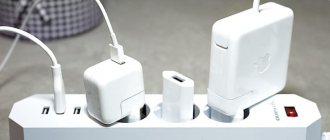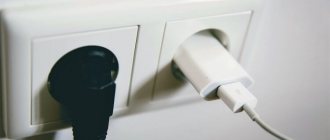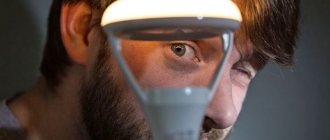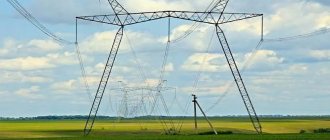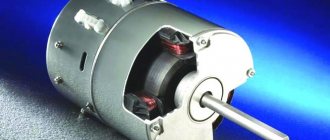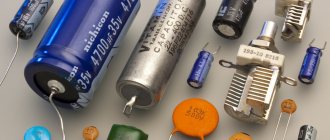One of the biggest horror stories that traditional and LED lighting experts scare us with is the so-called light pulsation.
Poorly assembled and cheap lamps are especially susceptible to this phenomenon. This parameter is characterized by the pulsation coefficient.
Let's look at how to detect harmful pulsations, how to measure them, what they depend on and what regulatory documents and rules are regulated.
The effect of light pulsations on the body and brain
If you delve deeper into this issue, you will find that not all pulsations are equally harmful. Some of them can even be ignored and not measured.
For the first time, the process of the influence of light pulsations on the human body was described in detail in the journal “Svetotekhnika” back in 1963. Summarizing the material presented in it, we can draw some conclusions.
For example, light pulsations with a frequency of up to 300 Hz really have a negative effect on our body.
With constant exposure to such light, the usual daily rhythm and general hormonal levels change. When flickering at a frequency of up to 120 Hz, our brain reacts to this “flickering” and tries to perceive non-existent information, processing it and loading itself. It is quite natural that this directly affects fatigue.
Here is a visual experiment and the results of an EEG of the brain. In the first case (Figure A), the person is sitting in a darkened room, and in the second (Figure B), he is in a room with pulsating lamps with a frequency of 120 Hz.
Look at abnormal peaks of activity and imagine how this affects your biorhythms and your overall well-being.
But if these pulsations have a frequency above 300 Hz, then they are simply not recorded in any way by the human body and brain.
And accordingly, they do not have any influence on him.
Negative impact
The human brain cannot fully process information that comes to the eyes with a frequency exceeding several tens of hertz. For this reason, frames in movies and on TV change at a frequency of 25-50 Hz. If the pulsation of the light flux is lower, it affects the eyes and is analyzed by the brain. A person can determine the brightness of the stream, colors, shades, contrasts. If information is presented at a different frequency, people subconsciously try to avoid it.
Medical research has shown that the eyes and brain actually perceive data with a frequency of up to 300 Hz, but not visually. A person does not feel the impact, so he does not take any measures. He associates the feelings of discomfort and fatigue with other reasons. Although the non-visual impact is not well understood, it is clear that it is quite profound.
Attention! The eyes do not perceive pulsation frequencies above 300 Hz, so there is no negative effect.
For short-term exposure to flicker:
- eyes get tired;
- attention decreases;
- a person gets tired quickly;
- brain function slows down;
- the functioning of the digestive organs is disrupted;
- nausea appears;
- circadian rhythms are disrupted.
With prolonged exposure to pulsation:
- insomnia and depression develop;
- vision decreases;
- pathologies of the gastrointestinal tract and cardiovascular system develop;
- brain functionality is impaired;
- performance decreases.
The most dangerous phenomenon in the workplace is the development of a stroboscopic effect at a flicker frequency of up to 80 Hz. A person has the illusion of slower movement and immobility of surrounding objects. This increases the likelihood of injury. As the frequency increases, diseases of the nervous system quickly develop.
GOST, rules and normative values
Based on these conclusions of scientists, GOST R54945-2012 “Methods for measuring coefficients” was developed. pulsations of illumination." GOST is valid and used by all manufacturers at the moment.
It describes in detail the measurement methods and what instruments should be used to do this.
The main question for the consumer is what the maximum value of the pulsation coefficient can be for different light sources in certain rooms.
These limit parameters are regulated by several sets of SP rules.
The minimum safe value indicated in them is 5%. Many other sources and articles on the Internet talk about figures of 3% or even 1%. So, in these sets of rules, there is no talk of such small values even close.
Here is a summary table of recommended pulsation coefficient values for different rooms:
At the same time, remember that for non-residential premises pulsations are not standardized at all.
Therefore, if somewhere you come across data on housing and communal services lamps that they have a pulsation of 10% or even 5%, you should not really believe such technical parameters.
For the vast majority of such lamps, measurements are simply not made, since they are not required by law.
Why do manufacturers need to spend extra money and increase the price of their goods compared to their competitors?
Definition and unit of measurement
The pulsation coefficient (Kp) is one of the characteristics that determines the quality of artificial lighting. To calculate Kp, the illumination level is measured and the minimum, average and maximum values are recorded. The data is then plugged into the formula below.
The pulsation coefficient of LED lamps is a dimensionless quantity. For ease of understanding, the obtained result is displayed in percentage equivalent. Using this formula, calculations are made based on measurements of harmonic vibrations. LED lamp drivers are a source of negative harmonic signals, which simplifies experimental measurements.
If there is pulsed noise in the radiation source, more complex calculations are used. However, this has nothing to do with the electrical circuits of LED lamp power supplies.
Monitors and smartphones
By the way, slightly distracting from light bulbs, it is worth noting that almost every second monitor has ripples above 30%, and in some you can find ripples under 100%.
Therefore, home light bulbs with 10% are still flowers in our everyday life. For example, you spend at least an hour or two every day staring at your smartphone screen. And they pulsate like an acid disco.
After this, many even wonder where their “legs grow” from and who is to blame for the gradual deterioration of their health.
Another interesting thing about cutoff numbers is that it doesn't make much difference to your brain whether you're sitting under a 20% or 100% light bulb.
In both cases the level of distress will be similar. Only the duration of the effect may differ.
Manufacturers rating
The production of LED lamps is now practiced by many companies, both well-known and little-known manufacturers. The cost of LED lamps today is quite impressive, so many people want to save money and purchase cheap products from little-known manufacturers. As a rule, such products do not meet many characteristics, and very important ones. Their color rendering coefficient is at the level of 60 and no more, and they are made from cheap components that cannot withstand the actual degree of use. The quality of such products is at the 50/50 level. In other words, if you buy a pair of lamps, one will work fine, but the other will quickly fail. In this case, the following statement is appropriate: the miser has to pay twice, which is proven by life. Therefore, it is better to immediately give preference to a well-known manufacturer, although its products are more expensive.
The highest quality lamps
It produces good quality lamps (LED) as well. These are European companies, although the main manufacturing facilities are located in China and other Asian countries. These companies control the quality of their products very strictly. In this regard, the prices for their products are appropriate. Lamps can cost from 800 to 1800 rubles, and it produces several products that differ in prices, since they are intended for several categories of consumers. Among their collection, it is possible to find products worth 100 rubles, as well as products worth almost 3 thousand rubles. Products costing from 400 to 800 rubles are mainly in demand.
Price-quality ratio
As a rule, the average price category corresponds to the best indicators of the price-quality ratio. There are products on the market from both domestic and foreign manufacturers.
So:
- Domestic produces products corresponding to prices from 60 to 360 rubles.
- from Hong Kong produces an extensive collection of lighting devices, costing from 75 to 400 rubles.
- , which in St. Petersburg produces LED lamps in the price range from 100 to 400 rubles.
- Domestic is considered the main manufacturer of such products, which can cost from 80 to one and a half thousand rubles.
- Domestic also refers to domestic and produces LED lamps in the price category from 65 to 850 rubles.
- Domestic has not been on the domestic market for long, but has already managed to gain trust. The products are stable and of high quality, costing from 90 to 520 rubles.
- produces relatively high-quality products in the price range from 75 to 800 rubles.
- The Chinese company produces light sources costing from 180 to 530 rubles, as well as unique light sources that can cost from 1000 to one and a half thousand rubles, and sometimes more.
Naturally, the light source market is not limited to the products of the above companies: in fact, there are many more of them, both well-known and not so well-known. Therefore, the choice of LED lamps is not simple. But the realities of our time require saving energy resources, and who wants to overpay for electrical energy, the cost of which is constantly growing.
When does the stroboscopic effect occur?
And even with Kp>20%, a stroboscopic effect may appear.
This is when moving and rotating objects (motor shaft, fan blades) will appear motionless to your eyes.
This is very traumatic. Therefore, in production facilities in enclosed spaces with artificial lighting, it is necessary to be very strict in choosing the right lamps.
Ripple in traditional lighting and methods to reduce it
High Kp values are characteristic primarily of discharge lamps with electromagnetic ballasts (DRL, DRI, DNAT).
Here they can easily reach values above 30%. By the way, ordinary incandescent light bulbs also have pulsations of up to 15%. But we don’t really notice this, since the effect is dampened by thermal inertia.
An incandescent light bulb is, first of all, a good heater (most of its energy goes into heat), and only then is it a light source.
Moreover, the more powerful the light bulb, the lower its coefficient.
Here the dependence is determined by the inertia of heating and cooling of the tungsten filament.
A very effective way to reduce the coefficient. pulsation, which for some reason few people use, is the installation at one point of several lamps powered by different phases. Here is a visual table for different types of lamps and the dependence of their ripples when connected to 1st, 2nd or 3rd phases.
A more radical method for DRL, LB lamps and the like is to replace the electromagnetic ballast with an electronic one, while simultaneously increasing the frequency to 400Hz.
By the way, many are still mistaken in thinking that LEDs have come a long way in terms of heat transfer and efficiency. This is not always true. And with the efficiency of LEDs, not everything is so smooth either.
Important information about LED flickering
LEDs, by their very nature, are direct converters of current into light, so they synchronously repeat the pulses that feed them at the same frequency (a picture of an LED ripple slowed down 120 times is shown at the beginning of this article). But this is in the case of a direct connection without any rectifier. In household LED lamps there is a driver, on which the LED pulsation depends (with the exception, perhaps, of most lamps with such tiny bases, like G9, where there is simply not enough space for the driver).
It should be noted that the efficiency of LED lamps is decreasing year by year, which is due to the improvement of LED technologies. But for old LEDs this coefficient exceeded 30%. So, if the LEDs installed 10-15 years ago have not yet failed, it would be better to replace them with new models
In addition, even among those LED lamps that are on store shelves today, you can find those that do not meet the requirements for the pulsation coefficient. Therefore, it is better to give preference to long-established manufacturers and conscientious sellers, so as not to buy products from a suspicious Chinese factory or run into a counterfeit of a famous brand.
LED Lighting and Flicker
In LED lamps, a lot depends on the build quality of the power supplies (drivers). If their output is not direct current, but rectified at industrial frequency, then a ripple of 30% is not so uncommon.
But in general, regarding LED light sources and coefficients. pulsations GOST clearly says:
Based on this, before making any measurements, make sure that the pulsation frequency from your lamp does not exceed 300Hz. Otherwise, you may not need to measure anything.
Although there are exceptions here - for example, professional light for photography or video shooting.
Here, even at values above 300Hz, you need to pay attention to any flickering. The fact is that when filming video and taking photographs, the frequencies of light sources are strictly tied to other sets of parameters - frame rate, shutter speed, etc.
Although there will no longer be any influence on a person, there will be a significant impact on the quality of shooting.
And the ripple factor is sharply increased by all kinds of dimmers, assembled according to the PWM principle and operating at frequencies up to 300 Hz.
Therefore, be extremely careful in their use.
How to remove pulsation in an LED lamp
LED lights may flicker both when off and on.
There are only three reasons:
- faulty electrical wiring;
- incorrect setting of the backlit switch;
- simplified driver diagram.
Diodes are negatively affected by old aluminum wiring if the wires are connected incorrectly or the insulation material has aged. When screwing in an incandescent LED light bulb with a base, there is always a phase present on the power supply. Due to the high sensitivity of the driver, current is supplied to it, which flows through the old insulation to the ground. Therefore, the LED lamp receives a small current, which is enough to charge the capacitor. The accumulated potential is periodically applied to the lamp.
If, after testing the circuit, it turns out that the wires and switch are connected correctly, the only correct solution is to replace the aluminum wiring with copper.
Attention! If powerful electrical appliances (warm floors, electric stove, boiler, heating boiler) are connected to the electrical network in a house or apartment, a magnetic field is created in the wiring. When lighting wires are placed nearby, induced voltage is generated, causing flickering.
If the backlit switch is not changed after replacing the lamp, the currents passing through it accumulate in the driver, charging the capacitor. When discharging, current flows from it to the LED lamp. To fix the problem, you should remove or improve the backlight. When choosing the second option, it is necessary to install a capacitor or resistor between the neutral and phase wires.
Important! If there are several LED bulbs in the lamp, you need to screw an incandescent lamp into one socket, which will act as a shunt.
If an LED lamp has a low-quality driver, it cannot provide a stable current at the pn junction. Cheap blocks divide the voltage into a sinusoid and smooth out ripples. They consist of a film and electrolytic capacitor, resistors connected in parallel to the circuit, and a diode bridge. As a result, an unstable current is produced, and the LED flickers and oscillates.
The only solution is to replace the electrolytic capacitor with an element with a higher resistance. But most often it does not fit in size. In addition, you need to remove the board from the LED lamp, find the capacitor, be able to unsolder it and solder another one.
Attention! The only correct solution is to replace the driver or buy a better light bulb.
In areas where the supplier uses outdated transformer equipment to supply electricity, the voltage on the line decreases. This negatively affects the operation of LED lamps. A current stabilizer solves the problem.
How and with what to measure the pulsation coefficient
If there are pulsations in your lamps and they are really harmful, then quality measurements in accordance with GOST are made using technology using an oscilloscope.
With its help, you can measure any pulsation frequency and calculate the coefficient for any lamps. The calculation formula is as follows (read GOST for more details):
In relatively operational rather than sterile laboratory conditions, the recommended measuring instruments should also be used. Here is their list:
One of the most popular devices is TKA-PKM 08.
Such a device digitizes the signal from the photosensor at a frequency of 3000 Hz. If the frequency of the light source is higher, then the data received from this device will already be significantly distorted. And it’s up to you to believe them or not.
Often, such devices combine several devices at once - lux meters, brightness meters, pulse meters.
All these devices are very expensive, as they undergo appropriate verification and are subsequently entered into the register. And this significantly increases the price of the device.
If you need measurements, as they say, “for yourself,” without subsequently submitting their results to government agencies, then no one forbids you to look towards cheaper analogues.
Moreover, there are copies with very good reviews.
For example, the Radex Lupin device.
Which frequency is the worst?
Most cheap Chinese LED light bulbs operate at frequencies up to 300Hz. Thus, imperceptibly day after day, worsening your well-being and exerting its destructive influence.
The human eye, without extraneous devices, is capable of distinguishing pulsations with a frequency of 60 to 80 Hz. Next comes a flickering invisible to us, but not to our brain.
Why are visible pulsating lamps “good”? Because we notice them and intuitively try to spend less time under their influence. Or we end up replacing them with others.
But the most dangerous flickers will be those that are not visually noticeable.
Due to the high intensity at these frequencies, our brain no longer has time to process all the information, but visual receptors continue to perceive it. And not as a visual component.
As a result, all this affects completely different parts of the brain and provokes changes in hormonal levels, biorhythms, increases fatigue and worsens well-being.
With high-quality manufacturers of lighting sources, even if there are pulsations, they occur at frequencies above 300 Hz. And there is no point in bothering with finding precise measuring instruments and calculating percentages here.
These light bulbs will still be absolutely safe and will not spoil your mood or health in any way.
Therefore, if some “specialist” scares you with inflated figures, making malicious remarks - they say, you see, even Phillips is not without sin, then why pay more?
Ask him a reasonable question: “At what frequency were these measurements obtained?” Be educated about LED lighting and don’t be fooled.
How to check a light bulb for pulsation - traditional methods
The simplest and most common household methods for checking pulsations include the following methods:
- mobile phone
Just look at the light from a light bulb through your smartphone screen. What is not visible to your eye will be very noticeable on camera.
However, keep in mind that some devices have built-in forced flicker reduction capabilities. Therefore, you may not see anything, although the effect will be present.
You need to bring it as close as possible so that the filament or diffuser takes up as much of the entire screen space as possible.
- camera
Take a photo of the light bulb without flash. If there are dark stripes on it, this is a sign of flickering.
- pencil method
Hold a pencil or ruler up to the light bulb and start flicking it like a fan or fan.
If the effect of “frozen blades” appears or you see several pencils, then the pulsation is greater than normal.
The clearer the outlines, the higher the coefficient. Such residual contours of figures due to light flickering appear in everyday life.
- spinning top
Spin the spinning top under a light source. If a stroboscopic effect appears, change the light bulbs.
However, similar folk methods detect pulsation up to 100 Hz. But from 100Hz to 300Hz, they can fail. Therefore, you should not rely on them.
The lamp flashes when turned on
The reasons for flickering and blinking of LED lamps when turned on are different.
One of them is abnormal operation of a power source that has electronic protection, for example, against current overload. It is triggered when the current through the LED lamp exceeds the specified rated lamp current, for example, by 30%. Or when the voltage in the network goes beyond the operating limits. Electronic protection will instantly turn off the power supply and turn it on automatically when returning to normal.
Mains voltage surges
Particularly noticeable are the moments of turning on power supplies assembled according to the circuit of pulse converters of alternating voltage into stable current or voltage. Their starting impulse can exceed five or even ten times the rated operating current for a fraction of a second. Those. Each switching on of an LED device - strip, spotlight or lamp - can lead to voltage dips in the 220 V supply network.
Graph of mains voltage surges.
Flashing can also be caused by lamp sensors, for example, human presence or movement, twilight, etc. Their incorrect operation can cause uncontrolled periodic switching on or off.
Flashing due to low mains voltage
Low voltage in old household power supply networks 220-230 V 50 Hz can occur when they are significantly overloaded with household electrical equipment. If previously the electrical fuses at the entrance to the apartment were rated 10-15 A, now automatic RCDs (residual current devices) react to a current of 25-50 A.
Small capacitor capacity
This reason may manifest itself not so much in blinking as in flickering, i.e. in supply voltage or current ripples. You can see the flickering:
- lateral or peripheral vision;
- using the “pencil test” - quickly move a pencil or ballpoint pen across the flow of light from the lamp. The appearance of visible intermediate positions of the pencil indicates the presence of high pulsations of the light flux, and therefore flicker;
- In certain phone modes, transverse stripes will be visible on the screen against the background of an object illuminated by flickering light.
To eliminate or reduce flicker (pulsation), you need to resolder the filter capacitor. They disassemble the lamp, disconnecting the bulb from the base, remove the driver printed circuit board from the base and change the capacitor in the filter or, if space allows, add another one.
Disassembled design of an LED lamp. The largest element on the board will be the filter capacitor(s).
Corn lamp. The brown “swollen” element is the filter capacitor.
